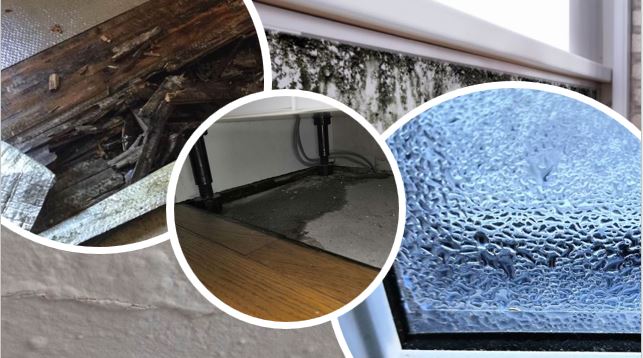What Causes Damp?
Damp problems in properties in the UK is a fairly common issue and most common of those we get asked about is damp on walls. There are a number of factors that can be behind damp on walls, and as we have said with other things (such as condensation on windows and mould problems), the key thing is to find out the cause of the damp.
This list applies to damp on internal walls, damp on external walls and damp on party walls, if your house is terraced, semi-detached or a flat.
Later we will look at what can be done about damp problems, but for now, let’s look a the main five causes of damp in properties. Although we are focusing on damp on walls on this page, these all apply to other common places damp is found, including – damp in walls (cavities), damp on ceilings, damp on floors and even damp on chimney breasts.
As we sometimes say, different things on this list can combine to make damp on walls worse but let’s look at these one by one.
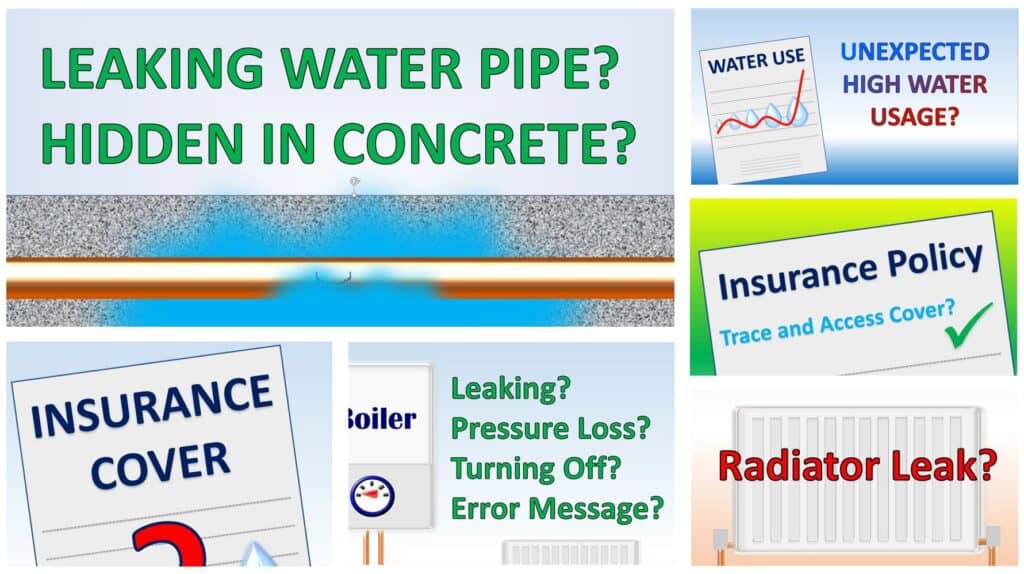
1 – Water Leaks behind Walls
You guessed it. Naturally in the line of work we do, a large amount of damp problems is caused by people having a water leak and that includes damp on walls. In our list of the top 10 signs of a water leak, number 1 on that list was visible signs of damp.
Of course in a property, the water leak itself can be of different types, for example;
- Indoor Water Leaks
- Outdoor Water Leaks
- Hot Water Leaks
- Central Heating Leaks
- Boiler Leaks
- Waste Water Leaks
- Business Water Leaks – in commercial properties
- Combinations of the above (e.g. internal cold water leak)
In order to help diagnose if you have a water leak, or to help understand the type or source of water, we also offer salts analysis tests which can help distinguish between a water leak, rising damp and penetrating damp from outside (more on these later!)
If you think you have a water leak, do not ignore it, get help from us with our leak detection services and we will help you find your water leak and assess the water damage caused.
2 – Condensation Problems on Walls
Condensation problems are another common cause of damp on walls. Almost all properties will have some sort of condensation but the problem is with excessive condensation which can in turn cause damp problems. We have written extensively elsewhere about condensation problems and how to stop condensation on windows, walls and ceilings etc.
Whenever we discuss condensation problems (and the same goes for mould problems – including black mould) the absolute key thing is to understand the cause. People tend to focus on removing condensation or mould but, if you are not careful and do not remove the cause, it will likely return. Focus on the cause of condensation, prevention is better than cure!
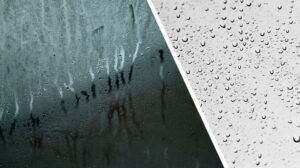
Rooms in the house where damp on walls caused by condensation tend to be in or close to water sources, especially things that add humidity or steam to the atmosphere in a house. This is especially the case from bathroom condensation, but it is also common in kitchens and laundry rooms.
We offer condensation surveys in properties, so if you need help with a condensation (or mould) problem, get in touch with our friendly team today. We will help you understand the extent of the problem, help identify causes and make recommendations.
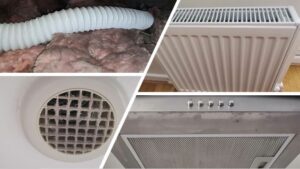
3 – Heating & Ventilation
This particular potential cause of damp on walls is very much related to number 2 on this list, condensation. They go hand in hand on many occasions but this is worthy of it’s own section because (a) not only can it contribute to damp on walls, it can (b) make the problem worse, or more difficult to resolve in the long term. We would also throw insulation into this group too because, as you will likely know, insulation can help keep properties warmer, retaining heat longer and help with having less cold surfaces in your property. On that subject…
Cold surfaces are certainly more susceptible to condensation and damp, not only can they cause something like condensation to form, but also because it will be less likely to dry any moisture that is present. Ventilation also helps to remove humidity in houses / moisture too. Both these can mean that, over time, damp on a wall can get worse. Think of it like trying to dry your clothes on a still cold day vs a windy hot / dry day. We look at this more in our blog post about cold spots.
We have an article on PIV Units (Positive Ventilation Units) which is worth reading too as, in some instances they can help with damp problems. We also have a guide to air bricks which are an important source of ventilation in many houses.
In our article explaining relative humidity, we discussed the science behind ‘dew point’ – put simply, condensation (and damp from condensation) is more likely to occur on a cold surface. We also have our own Dew Point Calculator to work this out. In this situation, having an infrared thermometer can be useful to measure surface temperature. See more on our page about dew point charts too.
Again to use an example – if you took a glass of normal room temperature water (or hot water for that matter) and had another with cold water or water with ice. If you then expose them to a high humidity location such as a kitchen or bathroom, the condensation would form much more on the cold glass (just as you see with a cold drink in summer). The same principle applies with damp on walls.
In fact, anti condensation paint in part tries to work on the basis of helping to insulate a surface more to make it less likely to form condensation. Read our article on anti condensation paint to see if we think it is an effective solution.
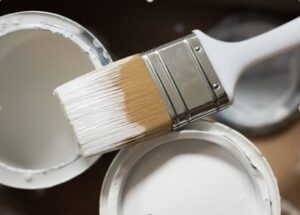
On the subject of condensation causing damp on walls, remember that if the problem is bad, moisture can run down a wall or window etc and pool at the bottom. This can lead to damp on floors or other surfaces. In especially bad cases, it can even (over time) go through into floors and possibly cause a ceiling leak or ceiling damage too.
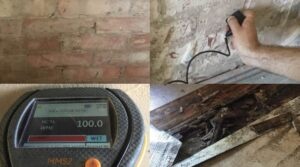
4 – Rising Damp on Walls
Rising Damp is something that people often jump to as the reason for damp on walls, partly because it is a familiar phrase to people. It is a common cause of damp on walls, especially at lower levels of a property in contact with the ground but it is important not to jump to conclusions and to understand if you do actually have rising damp. After all if it is something you want to get fixed and repaired (that is a whole other subject) you want to make sure that the expense and disruption is for the real cause.
We offer damp surveys in properties to help understand the cause of damp on walls.
Just as we said earlier for other causes of damp on walls, one of the things to help diagnose if you have rising damp is a salts test, which is part of the service we offer. This simple but effective test is very valuable to understand if nitrates and / or chlorides are present in moisture. That in turn gives you information to understand if it is a water leak, rising damp or penetrating damp (more on that next!).
Something that can have a big impact on the likelihood of having rising damp on walls is the age, construction and condition of your property. This is the case for many things on this list but arguably especially for rising damp. We will look at this more later.
What is Rising Damp?
Put simply, rising damp is moisture rising up, mostly from ground level, up through the fabric of a building into walls at low level. This is caused by a capillary effect and is more common in older properties and / or properties that do not have damp prevention / proofing methods such as damp proof courses or damp proof membranes to help stop this moisture rising.
What is a Damp Proof Membrane?
A damp proof membrane is a material designed to not allow moisture to travel through it, preventing rising damp, penetrating damp etc. It forms an impermeable barrier to moisture helping to protect the fabric of a building.
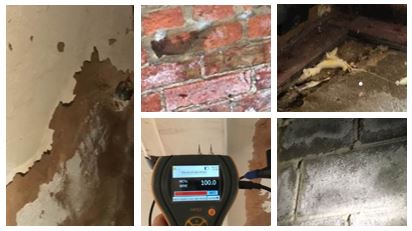
5 – Penetrating Damp on Walls
Penetrating Damp is a somewhat misunderstood phrase that can cover a variety of different things causing damp on walls, so let’s start with a simple explanation;
What is Penetrating Damp?
Penetrating Damp on Walls is usually caused by water or moisture external to the property, entering (or penetrating) through the outer walls or fabric of a building. This can be caused by damage or a defect to the building (for example a cracked wall) or through passing through a material which is not damp proof. Accordingly, it is more common in older properties, especially those without a cavity wall. The external water can come from different sources but, commonly, it is directly or indirectly from rain water / weather damage.
We have written a detailed article explaining about penetrating damp too
Penetrating damp on walls can look very similar to rising damp so it is important not to confuse the two. Like rising damp, it is often found at ground level. This can sometimes be because of rain water (or something like a broken drain pipe) running down an external wall, collecting at the base and penetrating the property walls.
Like rising damp, it is more common on older properties and visually can look similar. As we will discuss in a moment, older properties (apart from having older, often less effective damp prevention materials) are obviously more likely to have suffered from degradation to materials over the years which can cause water to penetrate more easily.
As part of our damp survey services, we have various tests and moisture mapping techniques to help understand this in more detail and to help identify short and longer term solutions.
Age, Construction and Condition of Properties
As we have said several times above, all of the problems that can cause damp on walls shown above can be caused, or made worse by the age, construction and condition of properties. We frequently visit properties with damp on walls that tick one or all of these boxes, so let’s look at that more and explain why that can be a contributing factor.
Age of Properties and Damp on Walls
As with many things, as technology in construction has moved on both understanding the cause of damp on walls and how to prevent it has improved. Well designed modern houses use materials and systems to help prevent issues with damp.
That is not to say that older properties did not think about damp proofing properties – for example using slate as a damp proof course (DPC) in construction instead of modern plastics and rubbers. But things have moved on and there are generally more measures taken. The concept of ‘breathable’ but waterproof materials has been introduced over the years too, just like we have with raincoats. They help prevent moisture from entering but also allow the property to ‘breath’.
Even something like the brickwork and mortar used have changed over the years to help keep properties more resistant to damp over time.
As we said earlier, the other factor is obviously that older properties will have likely degraded over time through general exposure to the elements and general wear and tear. This can often be seen in something like damp on chimney breast walls which may be exacerbated by the fact that often fires are disused (so less heat to dry chimneys) or blocked up – preventing air flow.
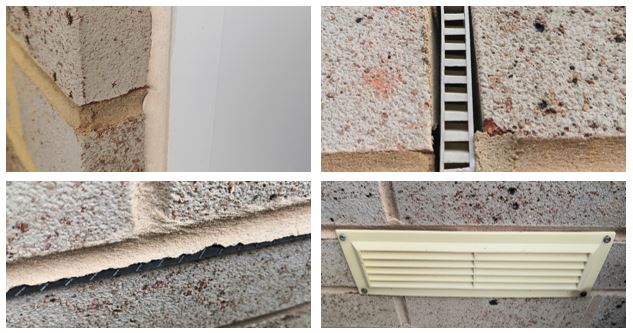
Construction of Properties
Alongside the age of properties, construction of properties plays an element in how protected a building is against damp. This can include things such as:
- Cavity walls and cavity wall insulation
- Further to that, other insulation in the property
- Ventilation, air flow and air bricks
- Related to that, voids under floors
- Membranes, weep vents, trickle vents
- Windows and door construction and seals around them
- Heating systems, including under floor heating
- Materials – bricks, stone, render etc.
Cavity walls, top on that list, are a good example. As well as their insulation properties, they provide an air gap so that even if the outer skin of bricks is damp etc, moisture cannot wick across easily, and so protecting the inner later of wall making damp on those walls less likely.
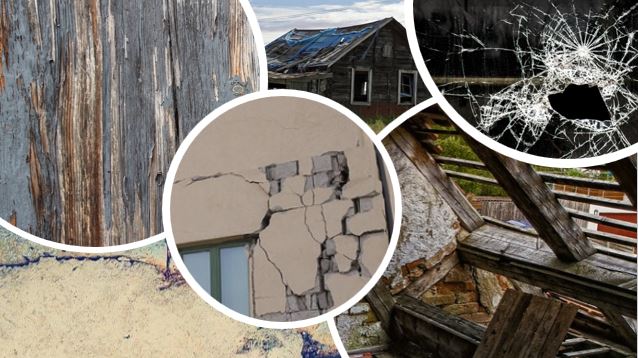
Condition of Properties
Of course none of the above will matter if a property is in a poor state of repair or damage. As we said earlier, older properties may be more prone to this but even a modern property that is damaged can compromise the integrity of the damp proofing materials and measures.
If general repairs are not kept on top of, or damage not fixed asap you can make the situation worse. Don’t ignore such problems as they are very unlikely to get better!
On top of that, you need to be careful that you are not invalidating your home insurance because of this whole area of property disrepair. Check your policy but it is possible that your insurer may not pay a claim, if say for example you have ignored a hole in your roof or something similar causing a roof leak!
For more on this, check out this guide from the ABI (Association of British Insurers) which covers wear and tear and maintenance etc. As usual, check with your own insurer if in doubt. Remember also that, if you have trace and access cover and damp on walls is caused by a leak you cannot find, your insurance company will likely pay for that service for you and any repairs you are covered for.

Resolving Problems with Damp on Walls
After everything we have said above, clearly people are interested in the best way to resolve an issue with damp on walls in their property. As you can hopefully understand, that will certainly depend on the cause of the damp. There is no one size fits all solution to damp problems, it depends on the cause. So, in general, let’s look at each of our main 5 causes one by one with a very quick summary of each.
- Water Leaks – firstly find and fix the leak, assess the scale and severity of damage, then carry out any water damage restoration (which may include drying of the property with dehumidifiers, perhaps a desiccant dehumidifier system) and finally reinstate the property back to it’s original pre-incident condition.
- Condensation – understand and assess the scale of the issue, find the cause (or causes as is often the case), resolve the issues affecting the condensation build up, carry out damage repairs and drying if needed. Reinstate and redecorate back to pre-incident condition.
- Heating & Ventilation – like the previous example, understand the scale of the issue and cause, resolve the issues causing the build up (the scale of this will depend – as will cost), carry out property damage repairs and, again finally, reinstate and redecorate as above.
- Rising Damp and Penetrating Damp – as we explained above, these are two different things (although they can happen at the same time too!) but the solutions are similar. Firstly identify which is the cause of the damp, understand how the construction, age and condition of the property has contributed to this (this is where expertise comes in), understand what can be done to stop or at least improve the situation. As you might expect, there is a huge range of solutions and they will depend greatly on the scale of the problem and the property itself. This is a whole other subject to cover another time but if the problem is bad, large scale and the property is old all these things (and others can have an effect). The best solution will in part be based on how the homeownder wishes to proceed, especially bearing in mind the possible cost and disruption. You may have limitations too depending on how the property is built or if, for example the building is listed.
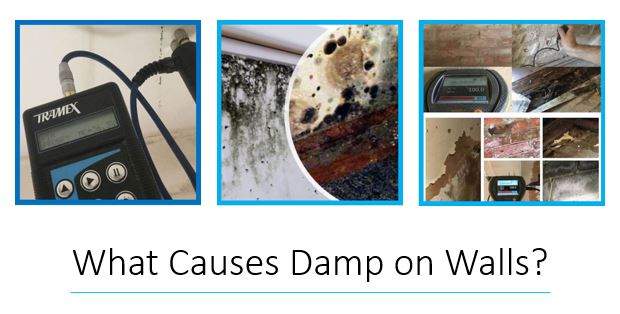
Remember, as we have said before, sometimes something like damp on walls can be affected by more than one of the things we have covered. It is not unusual to go to a property which has had a water leak and has issues with rising or penetrating damp too. As you might expect, this complicates matters further and is a different technical challenge.
If you have a problem with damp on walls, get in touch with us today and our expert team will discuss your individual property and needs to best suit you. For more information on this area, please read our article about types of damp, you may also find our article about efflorescence on bricks interesting.
